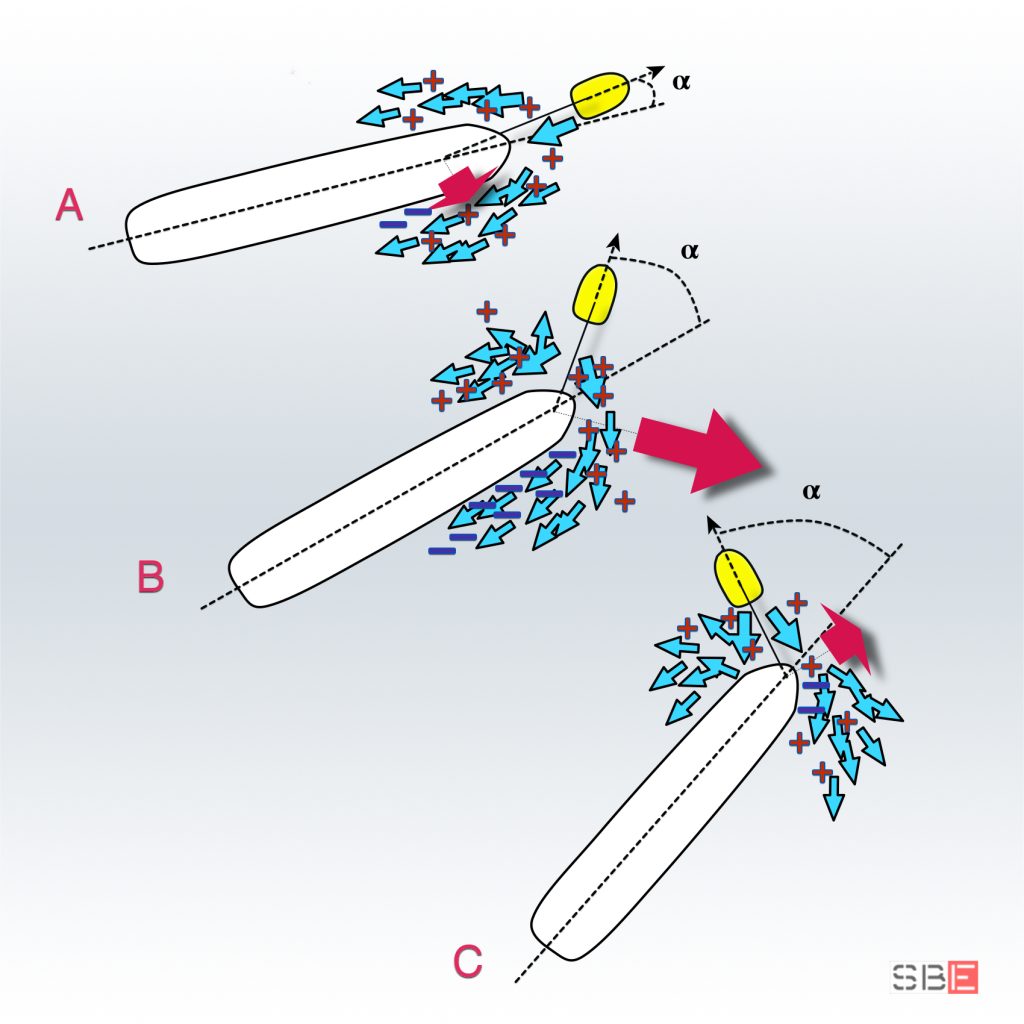Interactions and “Coanda Effect” Copy
When we talk about interactions, we often focus on the effect of the ship’s movement under the influence of a variable force, trying to memorise every possible case. This approach is not always the best as it is not easy, without continuous practice, to keep the memory of the hypothetical case and then quickly transfer it into practice. It is much easier to understand the concept behind interactions, whether they occur between ship and ship, ship and dock, ship and seabed, etc.
The interactions, whatever they are, are generated by attractions and repulsions derived from positive or negative pressure fields that the fluid causes when compressed or expanded. If we imagine a portion of water squeezed between the ship’s mass and the quay or sucked in by the dragging of the hull, we have a clear idea of the mechanism that repels or attracts our vessel.
Once we have learned the concept, we can apply it to every possible case naturally and quickly. We can predict the unexpected behaviour of our ship even before it occurs. We can be ready and promptly compensate or anticipate a particular unwanted effect or, instead, wait for it to help us in our purpose.
If we schematise it, highlighting the pressure fields as in the following drawing, we can make the first analysis:

The tug pull’s traction effect may be ineffective when the negative pressure (-) is more significant than positive (+).
Suppose we imagine these pressure fields present around the ship and expand or decrease them depending on the position of the hull concerning the surrounding environment and the slipstreams in action. In that case, we can get a precise picture of what awaits us.
We keep this important topic in its embryonic state, and we will address this in-depth later when we include all the forces acting on our ship and the actions needed to contain or exploit them. We will limit ourselves to illustrating three examples that also involve the slipstream effects caused by the moving propellers.
1. Turning
As we have already seen, the effects of the propeller play a fundamental role in the turning process. Depending on the type of propeller, we have several factors to consider to make the most of the manoeuvring characteristics of our ship.
Suppose we can not consider them in modern naval units equipped with azimuths of great powers. The pressure fields created during the manoeuvre in traditional propellers can considerably influence. With the engine astern, the pressure – formed by the water pushed by the propeller in motion – increases as the speed decreases. Due to the Paddle-wheel effect, the ship’s stern goes to one side and the slipstream to the other. When the vessel stops, the wake runs along the side, increasing the pressure and partly helping the rotation.
Before the advent of satellites, the wake position was the preferred way to evaluate the moment the ship stopped during the turning. The ‘mid-ship wake’ corresponds to zero speed.
When the ship starts to go back, the wake goes beyond its centre and can have a slowing effect on the rotation due to the pressure exerted on the forward part. If conditions are unfavourable, e.g. heavy ship, shallow water, current or wind, the pressure can be such that it stops or reverses rotation.
2. Mooring
We have seen an effective way of controlling the undesirable effect that causes the bow to lead towards the quay when we moor on the “unfavourable” side. Often, we have to moor ships of medium or small size, equipped with bow thruster and flap rudder. On paper very easy to manoeuvre, so the use of the anchor does not fall within the range of options.
During the final phase, when we are close to sending the lines, and we have to use the engine to stop the motion, the pressure of the wake is wedged between the ship and the quay and produces two effects: a) it increases the distance of the stern. b) It then increases the space of the bow when the pressure field exceeds the centre of the ship.
The characteristics of the ship allow us to compensate for any effect. Still, it is not uncommon that the approach to the quay may be challenging in the presence of concomitant causes such as wind or strong current.
3. Unmooring
We can experience another example of how we can use the pressure of the wake during manoeuvring in unmooring.
Imagine a ship equipped with a right-handed fixed pitch propeller moored on the quay with its starboard side to better visualise it. The vessel must proceed backwards to leave the berth. If there are no external elements such as wind or current that force us to evaluate the use of the tug, we can use the wake in the following way:
We lighten the mooring to only the spring at the bow to avoid sliding forward. We do not open the stern, but we run the engine astern to produce a slight sternway. We let go of the spring and stopped the engine. Due to the right-handed effect, the ship will open the stern from the quay. The wake produced will wedge between the vessel and the pier and, as the vessel retreats with the engine stopped. The pressure created will keep the bow safe by acting as a “water cushion”.
As mentioned above, the one described is only one of the many possible manoeuvres. There are many variables to consider: the solid quay or pier where the water flows freely, intensity and direction of wind and current, variable or fixed pitch, immersion, etc. Still, we will have the opportunity to analyse them all in the next dedicated course.
